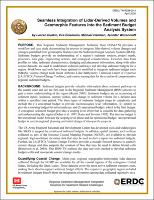Please use this identifier to cite or link to this item:
https://hdl.handle.net/11681/36296| Title: | Seamless integration of lidar-derived volumes and geomorphic features into the Sediment Budget Analysis System |
| Authors: | Dunkin, Lauren M. Eisemann, Eve R. Hartman, Michael A. Wozencraft, Jennifer M. |
| Keywords: | Sediment transport Sedimentation and deposition Coast changes Optical radar Remote sensing |
| Publisher: | Coastal and Hydraulics Laboratory (U.S.) Engineer Research and Development Center (U.S.) |
| Series/Report no.: | Technical Note (Regional Sediment Management Program (U.S.)) ; no. ERDC/TN RSM-20-4 |
| Abstract: | This Regional Sediment Management Technical Note provides a workflow and case study documenting the process to integrate lidar-derived volume changes and changes quantified from geomorphic features into the Sediment Budget Analysis System. Sediment budgets provide an understanding of a region’s sediment sources, project needs, processes, data gaps, engineering actions, and ecological considerations. Elevation data from profiles or lidar, sediment characteristics, dredging and placement information, along with other coastal datasets, are used to understand sediment pathways and develop sediment budgets for a region. Workflows and tools have been updated or modified to integrate sediment budget tools, volume change tools (Joint Airborne Lidar Bathymetry Technical Center of Expertise [JALBTCX] Volume Change Toolbox), and remote sensing data for the creation of comprehensive regional sediment budgets. |
| Description: | Technical Note |
| Gov't Doc #: | ERDC/TN RSM-20-4 |
| Rights: | Approved for Public Release; Distribution is Unlimited |
| URI: | https://hdl.handle.net/11681/36296 http://dx.doi.org/10.21079/11681/36296 |
| Appears in Collections: | Technical Note |
Files in This Item:
| File | Description | Size | Format | |
|---|---|---|---|---|
| ERDC-TN RSM-20-4.pdf | 1.04 MB | Adobe PDF |  View/Open |